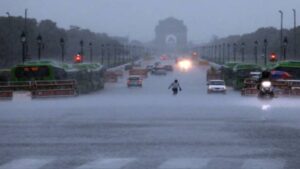Despite receiving over 200 mm of rainfall in July, Delhi experienced unusually hot and humid conditions, marked by low wind speeds, high moisture levels, and a lack of significant weather systems. Experts attribute this to the monsoon trough remaining predominantly south of Delhi-NCR, closer to Central India, which resulted in only light to moderate, patchy rains.
The India Meteorological Department (IMD) reported that Delhi’s average maximum temperature for July was 35.8°C, just above the long-period average (LPA). However, high humidity, consistently over 50% throughout the month, led to a Heat Index (HI) of 45.8°C. This HI, or ‘real feel,’ made the weather seem considerably warmer than the actual recorded maximum temperature.
Thermal discomfort was further compounded by a high average wet-bulb temperature of 28.9°C, with many days surpassing 30°C. Wet-bulb temperatures above 28°C pose challenges for physical labor, while temperatures over 32°C can be dangerous even for healthy individuals. At 35°C, the body’s ability to regulate temperature diminishes, risking heatstrokes and collapse.
Mahesh Palawat, vice president at Skymet, explained that the monsoon trough’s position near Central India for most of July led to some cloud cover and moisture but inadequate rainfall. The region also lacked active weather systems, which might have brought rain and increased wind speeds.
Palawat noted that areas north of the monsoon trough, such as Delhi-NCR, Haryana, Uttar Pradesh, and Punjab, experienced similar weather due to easterly moisture-laden winds, which kept humidity levels high throughout the day. The only notable western disturbance in Delhi occurred between July 22 and 25.
As of 5:30 pm, Safdarjung recorded 203.7 mm of rainfall for the month, close to the LPA of 209.7 mm. Rain fell on 17 days out of 30, but no heavy rainfall was observed. In contrast, Delhi saw 243.3 mm of rainfall in June, largely due to a single-day deluge of 228.1 mm on June 28, and 384.6 mm in July 2023.













